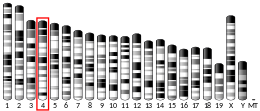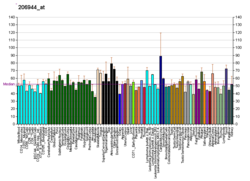5-HT6 수용체
5-HT6 receptor| HTR6 | |||||||||||||||||||||||||
|---|---|---|---|---|---|---|---|---|---|---|---|---|---|---|---|---|---|---|---|---|---|---|---|---|---|
| 식별자 | |||||||||||||||||||||||||
| 별칭 | HTR6, 5-HT6, 5-HT6R, 5-HT6 수용체, 5-HT6 수용체, 5-히드록시트리프타민 수용체 6 | ||||||||||||||||||||||||
| 외부 ID | OMIM: 601109 MGI: 1196627 호몰로진: 673 GeneCard: HTR6 | ||||||||||||||||||||||||
| |||||||||||||||||||||||||
| |||||||||||||||||||||||||
| |||||||||||||||||||||||||
| |||||||||||||||||||||||||
| 직교체 | |||||||||||||||||||||||||
| 종 | 인간 | 마우스 | |||||||||||||||||||||||
| 엔트레스 | |||||||||||||||||||||||||
| 앙상블 | |||||||||||||||||||||||||
| 유니프로트 | |||||||||||||||||||||||||
| RefSeq(mRNA) | |||||||||||||||||||||||||
| RefSeq(단백질) | |||||||||||||||||||||||||
| 위치(UCSC) | Chr 1: 19.66 – 19.68Mb | Chr 4: 139.06 – 139.08Mb | |||||||||||||||||||||||
| PubMed 검색 | [3] | [4] | |||||||||||||||||||||||
| 위키다타 | |||||||||||||||||||||||||
| |||||||||||||||||||||||||
5HT6 수용체는 내생 신경전달물질 세로토닌(5-hydroxytryptamine, 5HT)을 결합하는 5HT 수용체 아종이다.[5] G와s 결합하여 흥분성 신경전달물질을 매개하는 G단백질결합수용체(GPCR)이다.[5] HTR6는 수용체에 대한 인간 유전자 인코딩을 나타낸다.[6]
분배
5HT6 수용체는 거의 전적으로 뇌에서 발현된다.[7] 후각결절, 대뇌피질(전방 및 엔토르히날 영역), 측핵, 선조체, 가오산핵, 해마, 소뇌 분자층을 포함한 다양한 영역에 분포한다.[5][8][9] 외사성, 변연성, 피질성 부위의 풍부함을 바탕으로6 5HT 수용체가 운동 제어, 감정성, 인지, 기억력 등의 기능에서 역할을 한다고 제안할 수 있다.[7][9][10]
함수
중앙 5HT6 수용체 봉쇄는 다양한 뇌 영역에서 글루타마마테라믹과 콜린거 신경전달을 증가시키는 반면,[11][12][13][14] 활성화는 GABAergic 신호를 광범위하게 증가시키는 것으로 나타났다.[15] 5HT6 수용체들의 대항작용도 전두피질에서 도파민과 노르에피네프린 분비를 촉진시키는 반면 자극은 정반대의 효과를 가진다.[14][16][15]
적대자들에 대한 마약 타겟으로
5HT6 수용체에는 기능적으로 흥분 작용이 있지만 GABAergic 뉴런과 대체로 공동 국부화되어 있어 전반적인 뇌 활동 억제를 발생시킨다.[15] 이와 병행하여 5HT6 길항자는 인식, 학습, 기억력을 향상시키기 위해 가설을 세운다.[17] 라트레피르딘, 이달로피르딘(Lu AE58054), 인테피르딘(SB-742,457/RVT-101) 등의 작용제를 알츠하이머병 등 치매의 새로운 치료법으로 평가했다.[14][18][19] 그러나 라트레피르딘, 이달로피르딘, 인테피르딘의 3단계 실험은 효과를 입증하는 데 실패했다.
5HT6 대항제 역시 식욕저하와 체중감소를 유발하는 것으로 나타났으며, 그 결과 PRX-07034, BVT-5,182, BVT-74,316이 비만 치료제로 조사되고 있다.[20][21]
고통받는 사람들을 위한 약물 타겟으로
최근 5HT의6 작용제인 WAY-181,187과 WAY-208,466이 우울증, 불안, 강박장애(OCD)의 설치류 모델에서 활발히 활동하고 있는 것으로 나타났으며, 그러한 작용제는 이러한 조건에 유용한 치료법이 될 수 있다.[15][22] 추가적으로, 간접적인 5HT6 활성화는 선택적 세로토닌 재흡수 억제제(SSRIs)와 삼순환 항우울제(TCAs)와 같은 세로토닌 항우울제의 치료적 편익에 역할을 할 수 있다.[citation needed]
리간즈
많은 수의 선택적6 5HT 리간드가 개발되었다.[23][24][25][26][27][28][29][30][31]
고민자
완전고충인자
- 2-에틸-5-메톡시-N, N-디메틸트립타민(EMDT)[32]
- WAY-181,187
- WAY-208,466
- N-(inden-5-yl)imidazothiazole-5-sulfonamide (43): Ki = 4.5nM, EC50 = 0.9nM, Emax = 98%[33]
- E-6837 - 인간 5HT6 수용체에서의 완전 작용제
부분작용제
- E-6801[34]
- E-6837 - 랫드 5-HT6 수용체에서 부분작용제. 쥐에서 구강 활성이며, 만성[35] 투여로 체중 감소를 유발
- EMD-386,088 - 강력한 부분작용제(EC50 = 1nM)이지만 선택성이[36][37] 없음
- LSD - Emax = 60%[38]
적대자와 역작용제
- ALX-1161
- AVN-211
- BVT-5182[39]
- BVT-74316[20]
- 세라피르딘 - 선택적
- EGIS-12233 - 혼합 5HT6/5HT7 길항제
- Idalopirdine(Lu AE58054) - 선택적
- Intepirdine(SB-742,457/RVT-101) - 선택적 길항제
- Landipirdine(RO-5025181, SYN-120)
- 래트레퍼딘[40](비선택적) 및 아날로그[41]
- MS-245
- PRX-07034
- SB-258,585
- SB-271,046
- SB-357,134
- SB-399,885
- SGS 518 Fb: [445441-26-9]
- 로04-6790번길
- 로4368554번길[42]
- 비정형 항정신병 약물(서틴돌레, 올란자핀, 아세나핀, 클로자핀)
- WAY-255315 / SAM-315: Ki = 1.1nM, IC50 = 13nM[43]
- 로사 루고사 추출물[44]
유전학
HTR6 유전자의 다형성은 신경정신과 질환과 관련이 있다. 예를 들어, C267T (rs1805054) 다형성과 알츠하이머병 사이의 연관성이 나타났다.[45] 다른 사람들은 파킨슨병과 관련된 다형성을 연구했다.[46]
참고 항목
참조
- ^ a b c GRCh38: 앙상블 릴리스 89: ENSG00000158748 - 앙상블, 2017년 5월
- ^ a b c GRCm38: 앙상블 릴리스 89: ENSMUSG000028747 - 앙상블, 2017년 5월
- ^ "Human PubMed Reference:". National Center for Biotechnology Information, U.S. National Library of Medicine.
- ^ "Mouse PubMed Reference:". National Center for Biotechnology Information, U.S. National Library of Medicine.
- ^ a b c Kohen R, Metcalf MA, Khan N, Druck T, Huebner K, Lachowicz JE, Meltzer HY, Sibley DR, Roth BL, Hamblin MW (January 1996). "Cloning, characterization, and chromosomal localization of a human 5HT6 serotonin receptor". Journal of Neurochemistry. 66 (1): 47–56. doi:10.1046/j.1471-4159.1996.66010047.x. PMID 8522988. S2CID 35874409.
- ^ "Entrez Gene: HTR6 5-hydroxytryptamine (serotonin) receptor 6".
- ^ a b Woolley ML, Marsden CA, Fone KC (February 2004). "5HT6 receptors". Current Drug Targets. CNS and Neurological Disorders. 3 (1): 59–79. doi:10.2174/1568007043482561. PMID 14965245.
- ^ Ruat M, Traiffort E, Arrang JM, Tardivel-Lacombe J, Diaz J, Leurs R, Schwartz JC (May 1993). "A novel rat serotonin (5-HT6) receptor: molecular cloning, localization and stimulation of cAMP accumulation". Biochemical and Biophysical Research Communications. 193 (1): 268–76. doi:10.1006/bbrc.1993.1619. PMID 8389146.
- ^ a b Gérard C, Martres MP, Lefèvre K, Miquel MC, Vergé D, Lanfumey L, Doucet E, Hamon M, el Mestikawy S (January 1997). "Immuno-localization of serotonin 5-HT6 receptor-like material in the rat central nervous system". Brain Research. 746 (1–2): 207–19. doi:10.1016/S0006-8993(96)01224-3. PMID 9037500. S2CID 23364990.
- ^ Hamon M, Doucet E, Lefèvre K, Miquel MC, Lanfumey L, Insausti R, Frechilla D, Del Rio J, Vergé D (August 1999). "Antibodies and antisense oligonucleotide for probing the distribution and putative functions of central 5HT6 receptors". Neuropsychopharmacology. 21 (2 Suppl): 68S–76S. doi:10.1016/S0893-133X(99)00044-5. PMID 10432491.
- ^ Dawson LA, Nguyen HQ, Li P (May 2000). "In vivo effects of the 5HT(6) antagonist SB-271046 on striatal and frontal cortex extracellular concentrations of noradrenaline, dopamine, 5HT, glutamate and aspartate". British Journal of Pharmacology. 130 (1): 23–6. doi:10.1038/sj.bjp.0703288. PMC 1572041. PMID 10780993.
- ^ Dawson LA, Nguyen HQ, Li P (November 2001). "The 5HT(6) receptor antagonist SB-271046 selectively enhances excitatory neurotransmission in the rat frontal cortex and hippocampus". Neuropsychopharmacology. 25 (5): 662–8. doi:10.1016/S0893-133X(01)00265-2. PMID 11682249.
- ^ King MV, Sleight AJ, Woolley ML, Topham IA, Marsden CA, Fone KC (August 2004). "5HT6 receptor antagonists reverse delay-dependent deficits in novel object discrimination by enhancing consolidation--an effect sensitive to NMDA receptor antagonism". Neuropharmacology. 47 (2): 195–204. doi:10.1016/j.neuropharm.2004.03.012. PMID 15223298. S2CID 1736645.
- ^ a b c Upton N, Chuang TT, Hunter AJ, Virley DJ (July 2008). "5HT6 receptor antagonists as novel cognitive enhancing agents for Alzheimer's disease". Neurotherapeutics. 5 (3): 458–69. doi:10.1016/j.nurt.2008.05.008. PMC 5084247. PMID 18625457.
- ^ a b c d Schechter LE, Lin Q, Smith DL, Zhang G, Shan Q, Platt B, Brandt MR, Dawson LA, Cole D, Bernotas R, Robichaud A, Rosenzweig-Lipson S, Beyer CE (May 2008). "Neuropharmacological profile of novel and selective 5-HT6 receptor agonists: WAY-181187 and WAY-208466". Neuropsychopharmacology. 33 (6): 1323–35. doi:10.1038/sj.npp.1301503. PMID 17625499.
- ^ Lacroix LP, Dawson LA, Hagan JJ, Heidbreder CA (February 2004). "5-HT6 receptor antagonist SB-271046 enhances extracellular levels of monoamines in the rat medial prefrontal cortex". Synapse. 51 (2): 158–64. doi:10.1002/syn.10288. PMID 14618683. S2CID 6539467.
- ^ King MV, Marsden CA, Fone KC (September 2008). "A role for the 5HT(1A), 5HT4 and 5HT6 receptors in learning and memory". Trends in Pharmacological Sciences. 29 (9): 482–92. doi:10.1016/j.tips.2008.07.001. PMID 19086256.
- ^ Geldenhuys WJ, Van der Schyf CJ (2008). "Serotonin 5HT6 receptor antagonists for the treatment of Alzheimer's disease". Current Topics in Medicinal Chemistry. 8 (12): 1035–48. doi:10.2174/156802608785161420. PMID 18691131. Archived from the original on 14 April 2013.
- ^ Geldenhuys WJ, Van der Schyf CJ (July 2009). "The serotonin 5-HT6 receptor: a viable drug target for treating cognitive deficits in Alzheimer's disease". Expert Review of Neurotherapeutics. 9 (7): 1073–85. doi:10.1586/ern.09.51. PMID 19589055. S2CID 3066907.
- ^ a b Heal DJ, Smith SL, Fisas A, Codony X, Buschmann H (February 2008). "Selective 5-HT6 receptor ligands: progress in the development of a novel pharmacological approach to the treatment of obesity and related metabolic disorders". Pharmacology & Therapeutics. 117 (2): 207–31. doi:10.1016/j.pharmthera.2007.08.006. PMID 18068807.
- ^ Frassetto A, Zhang J, Lao JZ, White A, Metzger JM, Fong TM, Chen RZ (October 2008). "Reduced sensitivity to diet-induced obesity in mice carrying a mutant 5-HT6 receptor". Brain Research. 1236: 140–4. doi:10.1016/j.brainres.2008.08.012. PMID 18755168. S2CID 33355136.
- ^ Carr GV, Schechter LE, Lucki I (February 2011). "Antidepressant and anxiolytic effects of selective 5HT6 receptor agonists in rats". Psychopharmacology. 213 (2–3): 499–507. doi:10.1007/s00213-010-1798-7. PMC 2910165. PMID 20217056.
- ^ Trani G, Baddeley SM, Briggs MA, Chuang TT, Deeks NJ, Johnson CN, Khazragi AA, Mead TL, Medhurst AD, Milner PH, Quinn LP, Ray AM, Rivers DA, Stean TO, Stemp G, Trail BK, Witty DR (October 2008). "Tricyclic azepine derivatives as selective brain penetrant 5-HT6 receptor antagonists". Bioorganic & Medicinal Chemistry Letters. 18 (20): 5698–700. doi:10.1016/j.bmcl.2008.08.010. PMID 18793848.
- ^ Liu KG, Lo JR, Comery TA, Zhang GM, Zhang JY, Kowal DM, Smith DL, Di L, Kerns EH, Schechter LE, Robichaud AJ (February 2009). "Identification of a series of benzoxazoles as potent 5-HT6 ligands". Bioorganic & Medicinal Chemistry Letters. 19 (4): 1115–7. doi:10.1016/j.bmcl.2008.12.107. PMID 19152787.
- ^ Lee M, Rangisetty JB, Pullagurla MR, Dukat M, Setola V, Roth BL, Glennon RA (March 2005). "1-(1-Naphthyl)piperazine as a novel template for 5-HT6 serotonin receptor ligands". Bioorganic & Medicinal Chemistry Letters. 15 (6): 1707–11. doi:10.1016/j.bmcl.2005.01.031. PMID 15745826.
- ^ Sikazwe D, Bondarev ML, Dukat M, Rangisetty JB, Roth BL, Glennon RA (August 2006). "Binding of sulfonyl-containing arylalkylamines at human 5HT6 serotonin receptors". Journal of Medicinal Chemistry. 49 (17): 5217–25. doi:10.1021/jm060469q. PMID 16913710.
- ^ Benhamú B, Martín-Fontecha M, Vázquez-Villa H, Pardo L, López-Rodríguez ML (2014). "Serotonin 5-HT6 receptor antagonists for the treatment of cognitive deficiency in Alzheimer's disease". J. Med. Chem. 57 (17): 7160–81. doi:10.1021/jm5003952. PMID 24850589.
- ^ van Loevezijn A, Venhorst J, Iwema Bakker WI, Lange JH, de Looff W, Henzen R, de Vries J, van de Woestijne RP, den Hartog AP, Verhoog S, van der Neut MA, de Bruin NM, Kruse CG (2016). "Optimization of N'-(arylsulfonyl)pyrazoline-1-carboxamidines by exploiting a novel interaction site in the 5-HT6 antagonistic binding pocket". Bioorg. Med. Chem. Lett. 26 (6): 1605–11. doi:10.1016/j.bmcl.2016.02.001. PMID 26876931.
- ^ Ahmed M, Briggs MA, Bromidge SM, Buck T, Campbell L, Deeks NJ, Garner A, Gordon L, Hamprecht DW, Holland V, Johnson CN, Medhurst AD, Mitchell DJ, Moss SF, Powles J, Seal JT, Stean TO, Stemp G, Thompson M, Trail B, Upton N, Winborn K, Witty DR (November 2005). "Bicyclic heteroarylpiperazines as selective brain penetrant 5-HT6 receptor antagonists". Bioorganic & Medicinal Chemistry Letters. 15 (21): 4867–71. doi:10.1016/j.bmcl.2005.06.107. PMID 16143522.
- ^ Alcalde E, Mesquida N, Frigola J, López-Pérez S, Mercè R (October 2008). "Indene-based scaffolds. Design and synthesis of novel serotonin 5HT6 receptor ligands". Organic & Biomolecular Chemistry. 6 (20): 3795–810. doi:10.1039/b808641a. PMID 18843410.
- ^ Zhou P, Yan Y, Bernotas R, Harrison BL, Huryn D, Robichaud AJ, Zhang GM, Smith DL, Schechter LE (March 2005). "4-(2-Aminoethoxy)-N-(phenylsulfonyl)indoles as novel 5-HT6 receptor ligands". Bioorganic & Medicinal Chemistry Letters. 15 (5): 1393–6. doi:10.1016/j.bmcl.2005.01.005. PMID 15713394.
- ^ Glennon RA, Lee M, Rangisetty JB, Dukat M, Roth BL, Savage JE, McBride A, Rauser L, Hufeisen S, Lee DK (March 2000). "2-Substituted tryptamines: agents with selectivity for 5HT(6) serotonin receptors". Journal of Medicinal Chemistry. 43 (5): 1011–8. doi:10.1021/jm990550b. PMID 10715164.
- ^ Alcalde E, Mesquida N, López-Pérez S, Frigola J, Mercè R (February 2009). "Indene-based scaffolds. 2. An indole-indene switch: discovery of novel indenylsulfonamides as 5-HT6 serotonin receptor agonists". Journal of Medicinal Chemistry. 52 (3): 675–87. doi:10.1021/jm8009469. PMID 19159187.
- ^ Romero G, Sánchez E, Pujol M, Pérez P, Codony X, Holenz J, Buschmann H, Pauwels PJ (August 2006). "Efficacy of selective 5-HT6 receptor ligands determined by monitoring 5-HT6 receptor-mediated cAMP signaling pathways". British Journal of Pharmacology. 148 (8): 1133–43. doi:10.1038/sj.bjp.0706827. PMC 1752021. PMID 16865095.
- ^ Fisas A, Codony X, Romero G, Dordal A, Giraldo J, Mercé R, Holenz J, Vrang N, Sørensen RV, Heal D, Buschmann H, Pauwels PJ (August 2006). "Chronic 5-HT6 receptor modulation by E-6837 induces hypophagia and sustained weight loss in diet-induced obese rats". British Journal of Pharmacology. 148 (7): 973–83. doi:10.1038/sj.bjp.0706807. PMC 1751931. PMID 16783408.
- ^ Mattsson C, Sonesson C, Sandahl A, Greiner HE, Gassen M, Plaschke J, Leibrock J, Böttcher H (October 2005). "2-Alkyl-3-(1,2,3,6-tetrahydropyridin-4-yl)-1H-indoles as novel 5-HT6 receptor agonists". Bioorganic & Medicinal Chemistry Letters. 15 (19): 4230–4. doi:10.1016/j.bmcl.2005.06.067. PMID 16055331.
- ^ Jastrzębska-Więsek M, Siwek A, Partyka A, Antkiewicz-Michaluk L, Michaluk J, Romańska I, Kołaczkowski M, Wesołowska A (2016). "Study of a mechanism responsible for potential antidepressant activity of EMD 386088, a 5-HT6 partial agonist in rats". Naunyn Schmiedebergs Arch. Pharmacol. 389 (8): 839–49. doi:10.1007/s00210-016-1245-3. PMC 4939156. PMID 27106213.
- ^ Boess FG, Monsma FJ, Carolo C, Meyer V, Rudler A, Zwingelstein C, Sleight AJ (1997). "Functional and radioligand binding characterization of rat 5-HT6 receptors stably expressed in HEK293 cells". Neuropharmacology. 36 (4–5): 713–20. doi:10.1016/s0028-3908(97)00019-1. PMID 9225298. S2CID 41813873.
- ^ Hugerth A, Brisander M, Wrange U, Kritikos M, Norrlind B, Svensson M, Bisrat M, Ostelius J (February 2006). "Physical characterization of anhydrous and hydrous forms of the hydrochloride salt of BVT.5182 a novel 5-HT(6) receptor antagonist". Drug Development and Industrial Pharmacy. 32 (2): 185–96. doi:10.1080/03639040500466122. PMID 16537199. S2CID 39505659.
- ^ Wu J, Li Q, Bezprozvanny I (2008). "Evaluation of Dimebon in cellular model of Huntington's disease". Molecular Neurodegeneration. 3: 15. doi:10.1186/1750-1326-3-15. PMC 2577671. PMID 18939977.
- ^ Ivachtchenko AV, Frolov EB, Mitkin OD, Kysil VM, Khvat AV, Okun IM, Tkachenko SE (June 2009). "Synthesis and biological evaluation of novel gamma-carboline analogues of Dimebon as potent 5-HT6 receptor antagonists". Bioorganic & Medicinal Chemistry Letters. 19 (12): 3183–7. doi:10.1016/j.bmcl.2009.04.128. PMID 19443217.
- ^ Gravius A, Laszy J, Pietraszek M, Sághy K, Nagel J, Chambon C, Wegener N, Valastro B, Danysz W, Gyertyán I (2011). "Effects of 5-HT6 antagonists, Ro-4368554 and SB-258585, in tests used for the detection of cognitive enhancement and antipsychotic-like activity". Behav Pharmacol. 22 (2): 122–35. doi:10.1097/FBP.0b013e328343d804. PMID 21301322. S2CID 24948197.
- ^ Liu KG, Robichaud AJ, Bernotas RC, Yan Y, Lo JR, Zhang MY, Hughes ZA, Huselton C, Zhang GM, Zhang JY, Kowal DM, Smith DL, Schechter LE, Comery TA (November 2010). "5-Piperazinyl-3-sulfonylindazoles as potent and selective 5-hydroxytryptamine-6 antagonists". Journal of Medicinal Chemistry. 53 (21): 7639–46. doi:10.1021/jm1007825. PMID 20932009.
- ^ Na JR, Oh DR, Han S, Kim YJ, Choi E, Bae D, Oh DH, Lee YH, Kim S, Jun W (2016). "Antistress Effects of Rosa rugosa Thunb. on Total Sleep Deprivation-Induced Anxiety-Like Behavior and Cognitive Dysfunction in Rat: Possible Mechanism of Action of 5-HT6 Receptor Antagonist". J Med Food. 19 (9): 870–81. doi:10.1089/jmf.2016.3660. PMID 27331439.
- ^ Kan R, Wang B, Zhang C, Yang Z, Ji S, Lu Z, Zheng C, Jin F, Wang L (November 2004). "Association of the HTR6 polymorphism C267T with late-onset Alzheimer's disease in Chinese". Neuroscience Letters. 372 (1–2): 27–9. doi:10.1016/j.neulet.2004.09.007. PMID 15531082. S2CID 6061526.
- ^ Messina D, Annesi G, Serra P, Nicoletti G, Pasqua A, Annesi F, Tomaino C, Cirò-Candiano IC, Carrideo S, Caracciolo M, Spadafora P, Zappia M, Savettieri G, Quattrone A (March 2002). "Association of the 5-HT6 receptor gene polymorphism C267T with Parkinson's disease". Neurology. 58 (5): 828–9. doi:10.1212/wnl.58.5.828. PMID 11889255. S2CID 11490444.
추가 읽기
- Hoyer D, Hannon JP, Martin GR (April 2002). "Molecular, pharmacological and functional diversity of 5-HT receptors". Pharmacology Biochemistry and Behavior. 71 (4): 533–54. doi:10.1016/S0091-3057(01)00746-8. PMID 11888546. S2CID 25543069.
- Raymond JR, Mukhin YV, Gelasco A, Turner J, Collinsworth G, Gettys TW, Grewal JS, Garnovskaya MN (2002). "Multiplicity of mechanisms of serotonin receptor signal transduction". Pharmacology & Therapeutics. 92 (2–3): 179–212. doi:10.1016/S0163-7258(01)00169-3. PMID 11916537.
- Van Oekelen D, Luyten WH, Leysen JE (April 2003). "5-HT2A and 5-HT2C receptors and their atypical regulation properties". Life Sciences. 72 (22): 2429–49. doi:10.1016/S0024-3205(03)00141-3. PMID 12650852.
- Dubertret C, Hanoun N, Adès J, Hamon M, Gorwood P (April 2004). "Family-based association study of the serotonin-6 receptor gene (C267T polymorphism) in schizophrenia". American Journal of Medical Genetics Part B. 126B (1): 10–5. doi:10.1002/ajmg.b.20120. PMID 15048641. S2CID 24710946.
- Ullmer C, Schmuck K, Kalkman HO, Lübbert H (August 1995). "Expression of serotonin receptor mRNAs in blood vessels". FEBS Letters. 370 (3): 215–21. doi:10.1016/0014-5793(95)00828-W. PMID 7656980.
- Kohen R, Metcalf MA, Khan N, Druck T, Huebner K, Lachowicz JE, Meltzer HY, Sibley DR, Roth BL, Hamblin MW (January 1996). "Cloning, characterization, and chromosomal localization of a human 5-HT6 serotonin receptor". Journal of Neurochemistry. 66 (1): 47–56. doi:10.1046/j.1471-4159.1996.66010047.x. PMID 8522988. S2CID 35874409.
- Orlacchio A, Kawarai T, Paciotti E, Stefani A, Orlacchio A, Sorbi S, St George-Hyslop PH, Bernardi G (May 2002). "Association study of the 5-hydroxytryptamine(6) receptor gene in Alzheimer's disease". Neuroscience Letters. 325 (1): 13–6. doi:10.1016/S0304-3940(02)00221-5. PMID 12023056. S2CID 45464124.
- Ham BJ, Kim YH, Choi MJ, Cha JH, Choi YK, Lee MS (January 2004). "Serotonergic genes and personality traits in the Korean population". Neuroscience Letters. 354 (1): 2–5. doi:10.1016/S0304-3940(03)00753-5. PMID 14698468. S2CID 22448256.
- Bernotas R, Lenicek S, Antane S, Zhang GM, Smith D, Coupet J, Harrison B, Schechter LE (November 2004). "1-(2-Aminoethyl)-3-(arylsulfonyl)-1H-indoles as novel 5-HT6 receptor ligands". Bioorganic & Medicinal Chemistry Letters. 14 (22): 5499–502. doi:10.1016/j.bmcl.2004.09.003. PMID 15482912.
- Kang H, Lee WK, Choi YH, Vukoti KM, Bang WG, Yu YG (April 2005). "Molecular analysis of the interaction between the intracellular loops of the human serotonin receptor type 6 (5-HT6) and the alpha subunit of GS protein". Biochemical and Biophysical Research Communications. 329 (2): 684–92. doi:10.1016/j.bbrc.2005.02.040. PMID 15737640.
- Tao WA, Wollscheid B, O'Brien R, Eng JK, Li XJ, Bodenmiller B, Watts JD, Hood L, Aebersold R (August 2005). "Quantitative phosphoproteome analysis using a dendrimer conjugation chemistry and tandem mass spectrometry". Nature Methods. 2 (8): 591–8. doi:10.1038/nmeth776. PMID 16094384. S2CID 20475874.
- Lorke DE, Lu G, Cho E, Yew DT (2006). "Serotonin 5-HT2A and 5-HT6 receptors in the prefrontal cortex of Alzheimer and normal aging patients". BMC Neuroscience. 7: 36. doi:10.1186/1471-2202-7-36. PMC 1523198. PMID 16640790.
- Yun HM, Kim S, Kim HJ, Kostenis E, Kim JI, Seong JY, Baik JH, Rhim H (February 2007). "The novel cellular mechanism of human 5-HT6 receptor through an interaction with Fyn". The Journal of Biological Chemistry. 282 (8): 5496–505. doi:10.1074/jbc.M606215200. PMID 17189269.
외부 링크
- "5-HT6". IUPHAR Database of Receptors and Ion Channels. International Union of Basic and Clinical Pharmacology.
- 미국 국립 의학 도서관의 세로토닌+6+수용체(MesH)
- UCSC 게놈 브라우저의 인간 HTR6 게놈 위치 및 HTR6 유전자 세부 정보 페이지.
이 기사는 공공영역에 있는 미국 국립 의학 도서관의 텍스트를 통합하고 있다.







